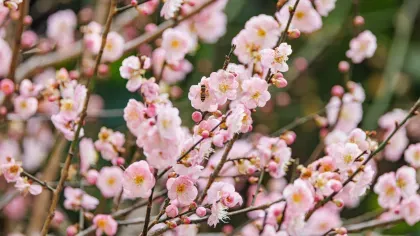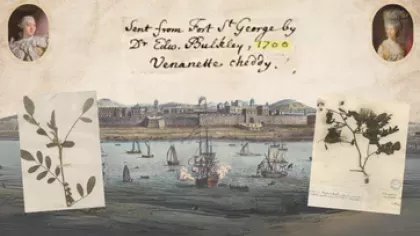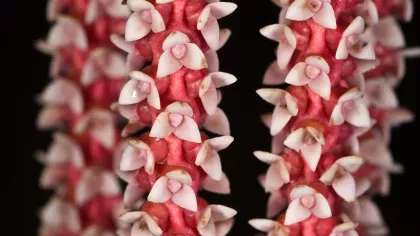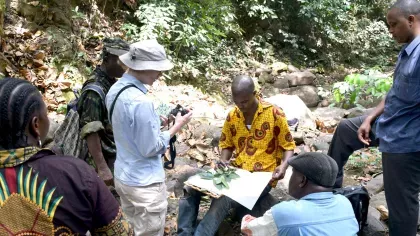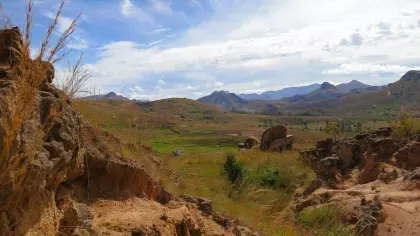26 September 2018
Training the next generation of seed conservationists
Bobbi Hope explains how training is increasing the capacity of the Millennium Seed Bank Partnership to conserve the world’s plant species.

Kew’s Millennium Seed Bank (MSB) is the largest and most diverse wild-species seed bank in the world. Seeds from more than 39,000 species of plants are stored in the underground, climate-controlled vaults in the Sussex countryside.
Not as well-known is the ever-growing team of scientists, botanists, technicians, educators and collectors who form the Millennium Seed Bank Partnership: a network of partners across more than 100 countries and territories, working to build a system of seed banks around the world to conserve species in their countries and regions of origin. And perhaps even less well known is the scale of training and skills transfer that takes place in the Partnership, to enable the best practices, technology, and ideas to be shared by everyone involved.
Fighting the threats against plants
On Monday 17 September the 11th Seed Conservation Techniques Course began, bringing together trainees from 13 different countries for the three-week event. Running the course is no small effort: 40 different members of staff from across Kew Science are involved, and all have spent several months preparing for this. The hard work of the staff deserves to be recognised, and it will be rewarded by adding 15 more people to the army that are already trained to conserve our most threatened and important plant species.
A brief history of MSBP training
Education has been a priority since the Millennium Seed Bank was opened in 2000. During the first 10-year phase, known as the Millennium Seed Bank Project, more than 1000 people were trained on new and improved seed conservation methods. In 2010 the Partnership was established, with the aim to build capacity to increase the scale of seed banking globally. Since then, nearly 1400 more people have been trained, either at the Millennium Seed Bank, or by its staff, overseas.
Training within the Millennium Seed Bank Partnership happens for several reasons: as new partnerships are developed, organisations often undertake work they haven’t done before so courses will be run at those institutions to train a large number of staff at once. One such course took place in Cibodas Botanic Garden, Indonesia in April 2017, to train staff from across the country and enable them to set up regional seed banks in their own botanic gardens. Sometimes organisations get new equipment or need training on particular processes, such as the 56 people trained over the past 3 years at the MSB in how to monitor seed collections. Or a course might be designed in response to a new threat to plant life, such as the two courses tat were run in New Zealand last December. These courses were organised in collaboration with Te Tira Whakamātaki, the Māori Biosecurity Network, after Myrtle Rust (a fungal pathogen known to infect native Myrtaceae species) was discovered on North Island.
My training highlights
My position coordinating Millennium Seed Bank Partnership training for the past 3 years means that I’ve had the privilege to deliver courses in some incredible places with some brilliant people. My first course was in Bhutan, a small country in the Himalayas that is difficult to access as a tourist. While my favourite anecdote from that trip is mistaking a bowl of hot chillies for green beans, and enthusiastically taking a large mouthful, the thing that I have valued most from these experiences is how much I have learnt myself. Training is never a one-way transaction, and every course reveals new solutions, techniques and inventive uses for equipment that our partners have found. One example came from a partner from the “Alexadru Borza” Botanic Garden in Romania. Handling very small seeds can be tricky, and static can cause them to jump around, so she used tools designed for making nail art to handle them. Cheap, easily available, and perfect for moving small things around, these are an ideal solution that has since been shared with several partners.
The ingenuity shown by my colleagues has also been a highlight. It’s useful to show seeds which have died to trainees, as the proportion which have died is used to predict how long the seeds will live for. But how can you be sure some of the seeds you are using for the training are dead? One trainer, who will not be named to protect their integrity, had the idea of secretly boiling a proportion, and then mixing them back in with the remaining seeds. When the tests were performed, some of the seeds had dutifully died, and we could teach the concepts we needed to without any problems. Cheaters never prosper, except when they’re trying to teach someone a lesson, it seems!
Training is vital to give more people the skills they need, to make and care for high-quality collections of seeds. High-quality collections are seeds which stay alive for longer, have more information stored about them, and are, ultimately, more useful as an insurance policy against extinction.



